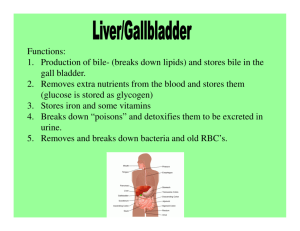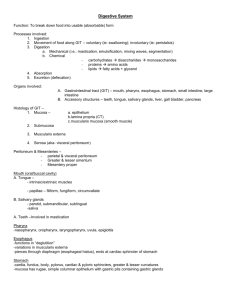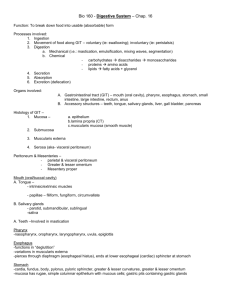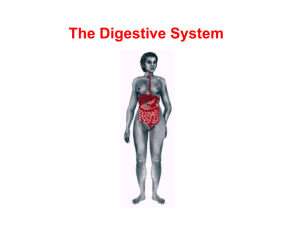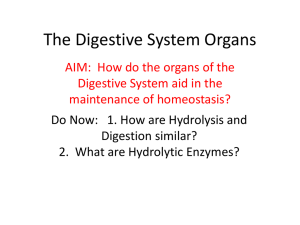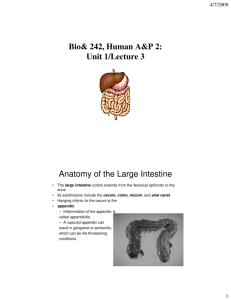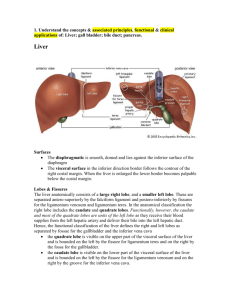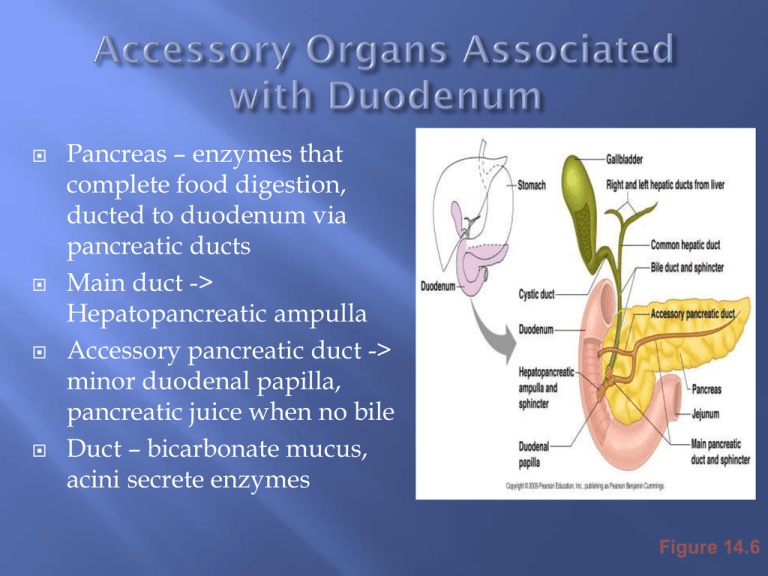
Pancreas – enzymes that
complete food digestion,
ducted to duodenum via
pancreatic ducts
Main duct ->
Hepatopancreatic ampulla
Accessory pancreatic duct ->
minor duodenal papilla,
pancreatic juice when no bile
Duct – bicarbonate mucus,
acini secrete enzymes
Figure 14.6
Trypsinogen, chymotrypsinogen,
procarboxypeptidase
Trypsinogen converted to Trypsin by
enterokinase in lumen of duodenum
Trypsin cleaves other two to make
chymotrypsin and carboxypeptidase, and
digests dietary protein
Pancreatic amylase, pancreatic lipase,
ribonuclease, deoxyribonuclease – active after
exposure to bile and ions in lumen
Bile and pancreatic juice secreted in response to
vagus stimulation (parasympathetic), inhibited by
sympathetic
Both stimulated by Cholecystokinin (CCK),
gastrin, and secretin
CCK released by duodenum in response to fat and
acid from stomach.
Contraction of gallbladder – bile into duct
Secretion of pancreatic enzymes
Relaxation of hepatopancreatic sphincter
Secretin – stimulates bile and pancreatic duct
secretion of bicarbonate, neutralize acid
4 lobes – rt, lt, quadrate,
caudate, sep by falciform
ligament = mesentary
Round ligament = remnant
of umbilical vein, blod from
umbilical cord to liver of
fetus
Portal hepatitis – entry of
hepatic portal vein, proper
hepatic artery, exit of bile
passages
Gallbladder associated
Hepatic lobules – central
veins, cuboidal hepatocytes
Hepatic Triad – artery + vein
(branches of proper hepatic
artery and hepatic portal
vein), bile ductule
Hepatic sinusoid – fenestrated
endothelium sep hepatocyte
from bloodstream, blood
plasma fills, blood directly
from intestine
Liver gets first dibs on glucose,
AA, iron, vitamis, nutrients
Removes hormones, toxins,
bile pigments, drugs
Secretes some blood proteins
Bile canaliculi, bile
ductules of triads, left
and right hepatic ducts >common hepatic duct
Hepatic and cystic duct
join = bile duct
Bile duct joins
pancreatic duct =
hepatopancreatic
ampulla
Enter duodenum=major
duodenal papilla,
heptopancreatic
sphincter (sp of Oddi)
Yellow-green color
Watery solution contain bile salts and
pigments, cholesterol, phospholipids,
electrolytes
Bilirubin – breakdown product of Hb
Only bile salts and phospholipids aid digestion
– emulsify fats, more SA for fat digesting
enzymes to work on
Thin walled green
sac
When not eating bile
stored here
Concentrated by
water removal
Fatty meal enters
duodenum, bile
released due to
hormonal stimulus
http://gogogojiteam.com/gallstone.html
Bile stored for too long
or too much water
removed, cholesterol
crystallizes
Blockage of common
hepatic or bile ducts
prevent bile into small
intestine, backs up into
liver
Bile pigments enter
blood and circulate,
yellowing jaundice
MAJOR digestive organ
3 subdivision
Duodenum
Jejunum
Ileum – meets large
intestine at ileocecal valve
Only able to process
small amount of food at
time, pyloric sphincter
controls food movement
Nearly all food absorption
3 structures in wall increase
absorptive surface
Microvilli – plasma membrane
– brush border enzymes –
digestion of protein and carbs
Villi – mucosa, w/in each are
capillaries and lacteal duct
(fat), food absorbed,
absorptive and goblet cells
Circular folds – deep fold of
mucosa and submucosa, don’t
disappear as fill with food
All decrease as move along
Peyer’s Patches increase –
collections of lymphatic tissue
Bacteria in food!
Figure 14.7
Absorptive cells line
villi, have microvilli
Contain brush border
enzymes – enterokinase
– remember pancreatic
Trypsinogen
Crypts of Lieberkuhn –
glands at base of villi, extend
to muscularis mucosa –
absorptive, goblet cells, stem
cells, Paneth cells (lysozyme,
phospholipase, defensins)
Brunner glands – submucosa
– bicarbonate mucus (unique
to duodenum)
Peyer patches – lymphatic
nodules - ileum
Segmentation vs. Peristalsis
Mix nutrients
Churn chyme, contact with mucosa for contact
digestion and absorption
Move to large intestine
Ileocecal valve to anus,
appendix
Absorb water and eliminate
indigestible food as feces
No villi
Goblet cells in mucosa
produce HCO-3 rich mucus,
lubricant
Divisions
Cecum, Appendix, Colon,
Rectum, Anal Canal
Colon – ascending,
transverse, descending,
sigmoid
Anus – internal and external
sphincters, anal columns and
sinuses
Figure 14.8
Bacterial flora – ferment cellulose and other
undigested nutrients
Synthesize B vitamins, vitamin K which are
absorbed by colon
Don’t get enough vitamin K in diet
Expel about 500ml of gas
Some from swallowed air, some from bacterial
digestion
12-24 from meal to feces
Reabsorbs water and electrolytes
Feces – 75% water and 25% solids
Solids – 30% bacteria, 30% undigested fiber, 10-20%
fat (not diet), epithelial cells, salts, mucus, etc
Stretching of rectum stimulates defecation
Intrinsic defecation reflex – stretch signals travel
myenteric nerve plexus to muscularis of
descending, sigmoid colon, rectum
Stimulates peristaltic waves
Internal sphincter relaxes – defecation if external also
relaxed
Need cooperation of parasympathetic defecation
reflex – spinal cord
Stretch of rectum, signal to sacral of spinal cord
Return via parasympathetic fibers, intensifies peristalsis
Parasympathetic fibers relax internal sphincter
Food must enter the
system to be acted
upon
Active and
voluntary
Figure 14.11
Foods must be processed my
multiple organs – move from
one to next
Swallowing is example
Movement depends mostly
on peristalsis vs.
segmentation
Segmentation – small
intestine, alternating
segments contract,
mechanical digestion
Mixing of food in
mouth by tongue
Churning of food in
stomach
Segmentation in
small intestine
Prepare food for
enzymatic digestion
by breaking into
smaller pieces
Food molecules broken down into building
blocks by enzymes
Reactions called hydrolysis rxn, water added as
bond breaks
Carbs (saccharides) we digest – sucrose,
lactose, maltose, and starch. Eat cellulose but
can’t digest, fiber
Proteins (a.a.) – polypeptides or peptides
Lipids (fats) – fatty acids and glycerol
Transport of
digested food into
blood from lumen of
GI tract
Must enter mucosal
cells by active or
passive transport.
Small intestine
major site of
absorption
Elimination of
indigestible food
from GI tract via
anus in form of feces
Figure 14.13 (1 of 3
Figure 14.13 (2 of 3))
Figure 14.13 (3 of 3)

